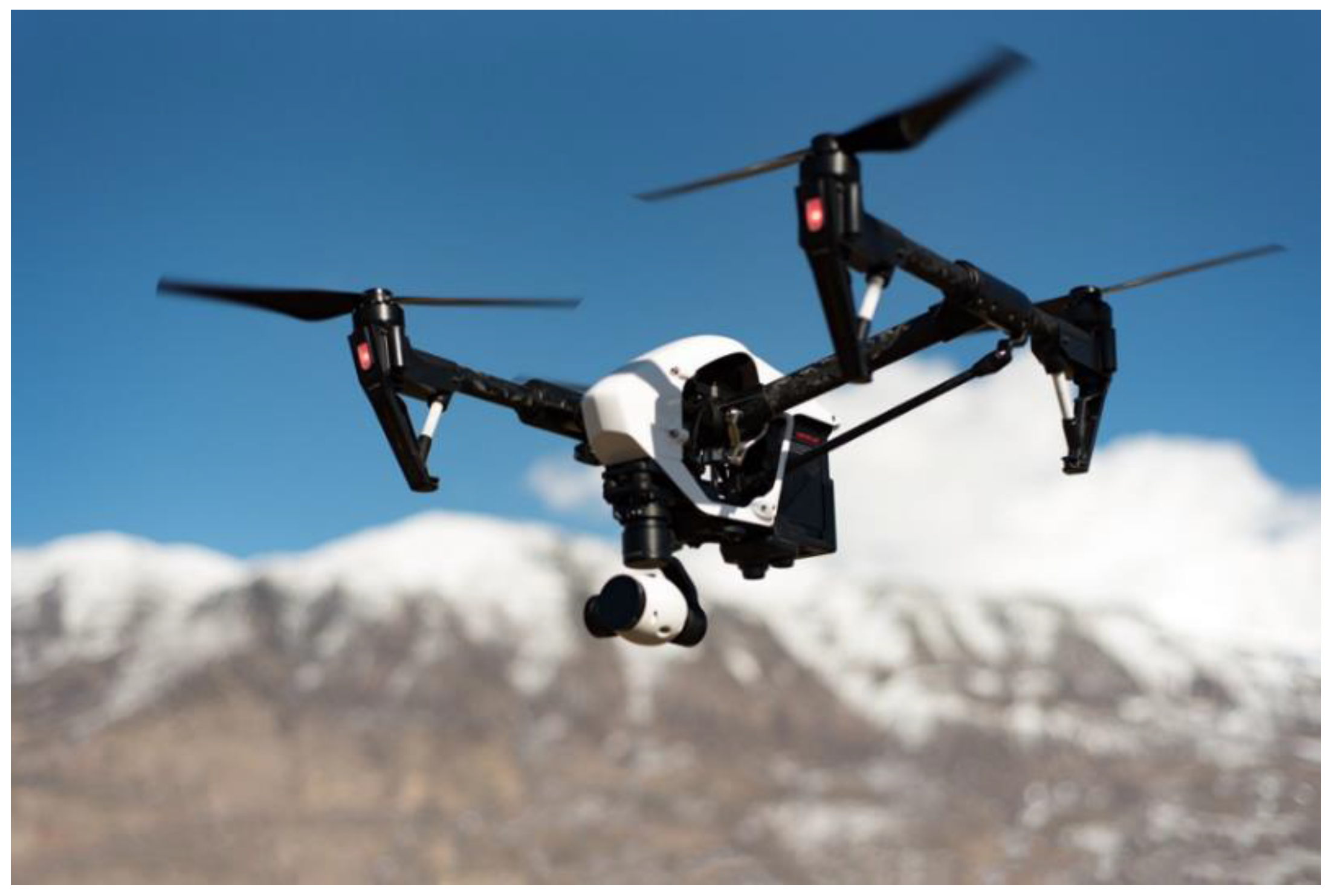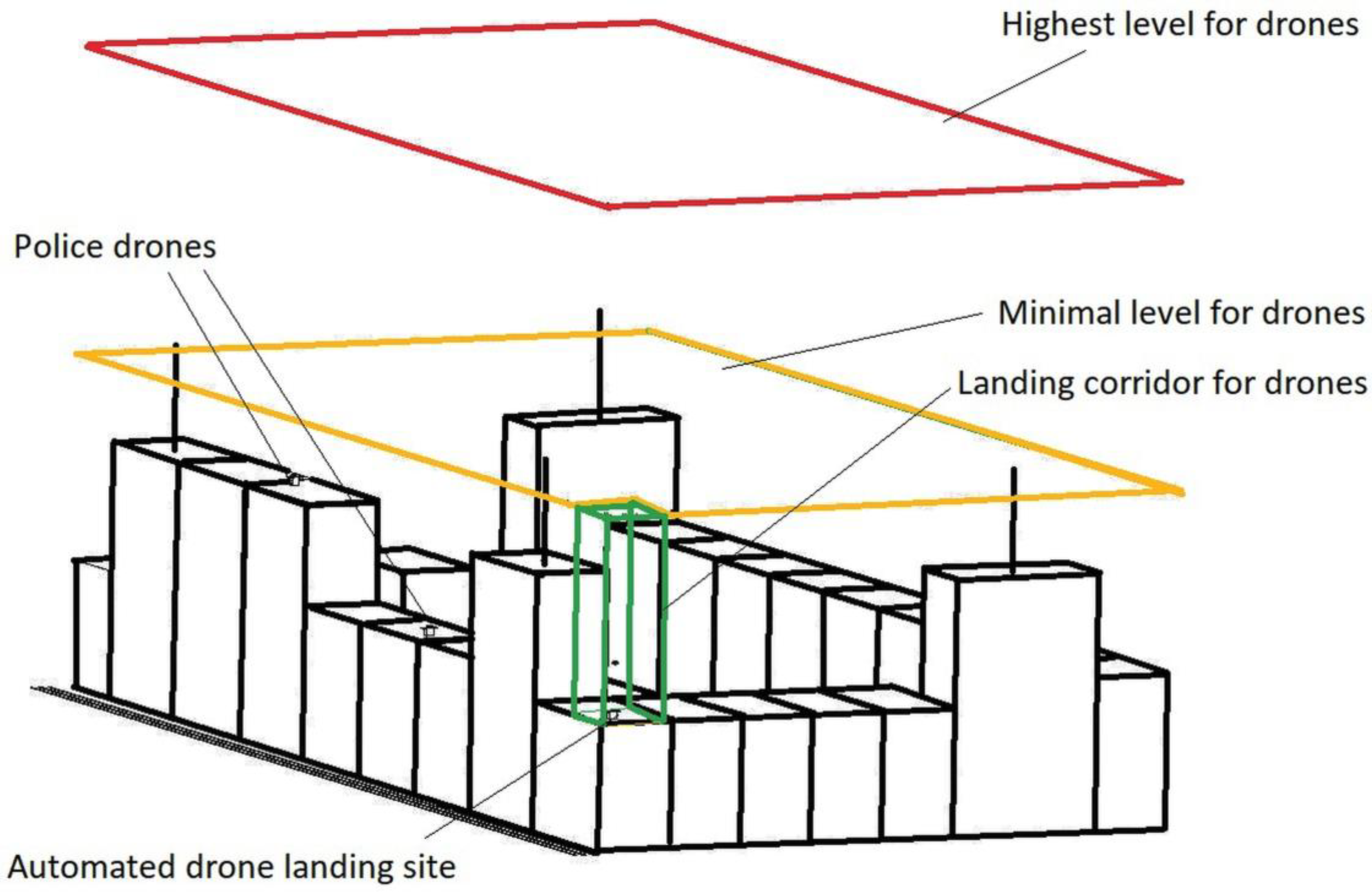Sustainable Usage of Freight Drones in City Centers, Proposition of Regulations for Safe Usage of Drones
Abstract
:1. The Freight Drone
2. Usage of Drones in City Centers
3. Review of the Regulations about the Usage of Drones
4. The Safety Problems of Freight Transport in Urban Areas by Drones
- Rapidly falling in a random place;
- The large mass of the drone falling down from the sky with high speed;
- The noise above the street at a high building level from the drone engine;
- The lights above the street at a high building level from the positioning lights of the drone;
- The unregulated minimal and maximal levels of flying drones;
- The unregulated speed of drones;
- The unregulated ways of flying drones.
5. Propositions for Regulations for Safe Usage of Freight Drones
- Permission of municipal governments
- 1.1
- Municipal governments are able to establish the safety agencies of flying control above cities.
- 1.2
- Municipal governments are able to establish the flying corridors above the roads and buildings where it will be possible to use drones, by establishing the positioning of RIFD (radio-frequency identification) points, on masts or buildings walls. This may help to create a digital map of positioning systems for drones.
- 1.3
- Municipal governments are able to establish the landing places for drones, where it will be possible to load and unload drones (for example, parking stations for packages and letters). In terms of landing, there will be places which realize the safety control of loads and drones.
- 1.4
- Municipal governments are able to build protection nets above some regions in city areas.
- 1.5
- Municipal governments are able to regulate the following:
- -
- The minimum and maximum heights of flying (see Figure 2);
- -
- The minimum and maximum speeds of flying;
- -
- The minimum distance above the road;
- -
- The minimum distance from one drone to another;
- -
- The minimum distance to buildings;
- -
- The maximum level of flying above buildings and roads;
- -
- The types of load which are prohibited to be transported by drones.
- The construction of drones
- 2.1
- The structure of drones must be composed of fireproof materials.
- 2.2
- The structure of drones must have landing legs or another structure which can protect the drone if it falls down with three levels of acceleration of gravity.
- 2.3
- The structure of drones after rapidly falling must be complete, and all parts must not be able to separate.
- 2.4
- The minimum stock of energy must be able to maintain the flight of the drone for two hours in cities.
- The moving system
- 3.1
- The propeller elements must be surrounded by permanent outside rings.
- 3.2
- The propeller elements must be permanently fixed.
- 3.3
- The engines must be protected from fire after collisions.
- Steering system
- 4.1
- The steering system must have an open structure, though it must be protected against being infected by viruses.
- 4.2
- The steering system must be able to maintain the position of the drone in one place in the flying space with 0.3 m precision.
- 4.3
- The steering system must be able to control the speed with 0.1 km/h precision.
- 4.4
- The steering system must be able to control the acceleration with 0.05 m/s2 precision.
- 4.5
- The steering system must include an autonomous anti-collision system for flight in the flying space.
- 4.6
- The steering system must be able to use the positioning RIFD points for orientation in the flying space.
- 4.7
- The steering system must have a panel for remote control that is able to be controlled by the safety agencies of flying control.
- Control system
- 5.1
- The control system of the drone must be able to realize the route of flying from two places in a space which is regulated by the safety agencies of flying control.
- 5.2
- The control system of the drone must be able to be controlled by the safety agencies of flying control at the time of flying in the flying corridors.
- 5.3
- The entrance to the flying corridors is only near the landing places.
- 5.4
- A change in the level and direction of flying is possible only in designated areas in the flying corridors.
- 5.5
- The control system must realize the safety regulations of flying directed by the safety agencies of flying control, especially the following:
- -
- The minimum and maximum heights of flying;
- -
- The minimum and maximum speeds of flying;
- -
- The minimum distance above the road;
- -
- The minimum distance from one drone to another;
- -
- The minimum distance to buildings;
- -
- The maximum level of flying above buildings and roads.
- 5.6
- The control system must have remote control capability for stopping and landing that can be controlled by the safety agencies of flying control.
- 5.7
- It is prohibited for an unclassified user to use a drone above a city or for a user to use a drone without a classification by the safety agencies of flying control.
- 5.8
- All alien drones will be overridden by any means or destroyed.
- Users of drones in city centers
- 6.1
- Each user of a drone in a city must be classified by the safety agencies of flying control.
- 6.2
- Each drone must have safety control and a classification assigned by the safety agencies of flying control.
- 6.3
- Each user must respect the regulation set by the safety agencies of flying control.
- 6.4
- Each user of a drone will be punished if they do not respect the law.
6. Discussion
7. Conclusions
Funding
Institutional Review Board Statement
Informed Consent Statement
Data Availability Statement
Conflicts of Interest
References
- Obraz Free-Photos z Pixabay, Darmowy do Użytku Komercyjnego Nie Wymaga Przypisania. Available online: https://pixabay.com/pl/photos/drone-p%c5%82ywaj%c4%85ce-kamery-1245980/ (accessed on 7 July 2021).
- Bettencourt, L.M.A.; Lobo, J.; Helbing, D.; Kuhnert, C.; West, G.B. Growth, innovation, scaling, and the pace of life in cities. Proc. Natl. Acad. Sci. USA 2007, 104, 7301–7306. [Google Scholar] [CrossRef] [PubMed] [Green Version]
- Bairoch, P. Cities and Economic Development: From the Dawn of History to the Present; University of Chicago Press: Chicago, IL, USA, 1988; ISBN 978-0-226-03465-2. [Google Scholar]
- Bundesgesetzblatt. Bundesgesetzblatt Für Die Republik Österreich, Jahrgang 2013. Ausgegeben am 20. Juni 2013, Teil I, 108. Bundesgesetz: Änderung des Luftfahrtgesetzes, (NR: GP XXIV RV 2299 AB 2349 S. 203. BR: AB 8984 S. 821.). 2013. Available online: http://www.ris.bka.gv.at/Dokumente/BgblAuth/BGBLA_2013_I_108/BGBLA_2013_I_108.html (accessed on 10 June 2021).
- ELI. Arrêté Royal Relatif à L’utilisation des Aéronefs Télépilotés Dans L’espace Aérien Belge, 10 AVRIL 2016. Mobilite et Transports, Eli—Système de Navigation par Identifiant Européen de la Legislation. Publication 15 April 2016. Available online: http://www.ejustice.just.fgov.be/eli/arrete/2016/04/10/2016014116/justel (accessed on 10 June 2021).
- VLOS. Knowledge Requirements for Pilots of Remotely Piloted Aircraft Systems 250 g Up to and Including 25 kg, Operating within Visual Line-of-Sight (VLOS) (TP 15263), 2nd ed.; 18 October 2018. Available online: https://www.tc.gc.ca/en/services/aviation/publications/tp-15263.html (accessed on 10 June 2021).
- VLOS. Flight Reviewer’s Guide for Pilots of Remotely Piloted Aircraft Systems 250 Grams (g) Up to and Including 25 Kilograms (kg), Operating within Visual Line-of-Sight (VLOS) (TP 15395), 1st ed.; September 2018. Available online: https://www.tc.gc.ca/en/services/aviation/publications/tp-15395.html (accessed on 10 June 2021).
- IAA. Drones–Q&A, The Use of Drones is Becoming More and More Prevalent in Ireland, and People who Intend to Operate Drones Should Be Aware of Their Responsibilities to Ensure That They Do So Safely. This Q&A Information Has Been Developed by the Irish Aviation Authority (IAA) to Provide Users with Information Regarding the Use of Drones in Ireland. 2017. Available online: https://www.iaa.ie/docs/default-source/default-document-library/drones-questions-and-answers-16-11-17.pdf?sfvrsn=3da404f3_2 (accessed on 10 June 2021).
- RPAS. Bij het gebruik van Remotely Piloted Aircraft System (RPAS), ook wel Drones Genoemd, Maakt Nederland Onderscheid Tussen Particulier/Recreatief en Beroepsmatig Gebruik. 2 March 2017. Available online: https://www.ilent.nl/onderwerpen/drones (accessed on 10 June 2021).
- Dz.U. Rozporządzenie Ministra Infrastruktury I Budownictwa z Dnia 8 Sierpnia 2016 r. Zmieniające Rozporządzenie w Sprawie Wyłączenia Zastosowania Niektórych Przepisów Ustawy—Prawo Lotnicze Zmieniające Rozporządzenie w Sprawie Wyłączenia Zastosowania Niektórych Przepisów Ustawy—Prawo Lotnicze. do Niektórych Rodzajów Statków Powietrznych oraz Określenia Warunków i Wymagań Dotyczących Używania Tych Statków, Które Zmieniło Zasady Lotów z Poprzedniego Rozporządzenia, Dz.U. 2016 poz. 1317. Pol. J. Laws 2016. Available online: http://isap.sejm.gov.pl/isap.nsf/DocDetails.xsp?id=WDU20160001317 (accessed on 2 August 2021).
- Paździor, G. Licencja na Drona” jak Prawo Jazdy. Tak Będzie WNP.PL. 2019. Available online: https://logistyka.wnp.pl/licencja-na-drona-jak-prawo-jazdy-tak-bedzie,342768_1_0_0.html (accessed on 10 June 2021).
- Blake, T. What is Unmanned Aircraft Systems Traffic Management? NASA. 28 May 2021. Available online: https://www.nasa.gov/ames/utm (accessed on 10 June 2021).
- Eur-Lex, Commission Delegated Regulation (EU) 2019/94 of 12 March 2019 on Unmanned Aircraft Systems and on Third-Country Operators of Unmanned Aircraft Systems (OJ L 152 11.6.2019, p. 1). Available online: https://eur-lex.europa.eu/legal-content/EN/TXT/?uri=CELEX%3A02019R0945-20200809 (accessed on 10 June 2021).
- Eur-Lex, Commission Implementing Regulation (EU) 2019/947 of 24 May 2019 on the Rules and Procedures for the Operation of Unmanned Aircraft (OJ L 152 11.6.2019, p. 45). Available online: https://eur-lex.europa.eu/legal-content/EN/TXT/?uri=CELEX%3A02019R0947-20200606 (accessed on 10 June 2021).
- Map of International UTM Implementations, China. 9 August 2018. Available online: http://gutma.org/maps/index.php?title=China#cite_note-3 (accessed on 10 June 2021).
- Xu, C.; Liao, X.; Tan, J.; Ye, H.; Lu, H. Recent research progress of unmanned aerial vehicle regulation policies and technologies in urban low altitude. IEEE Access 2020, 8, 74175–74194. [Google Scholar] [CrossRef]
- What is Jutm? Japan utm Consortium. Available online: https://jutm.org/en/about/ (accessed on 10 June 2021).


| Type of Region | Austria | Belgium | Canada | Ireland | Netherlands | Poland |
|---|---|---|---|---|---|---|
| nature space | prohibited | prohibited | ||||
| farm | prohibited | |||||
| settlement | prohibited | prohibited | min. 150 m | min. 120 m | prohibited | |
| aerodrome | prohibited | prohibited | min. 9 km | min. 5 km | prohibited | |
| group of people | prohibited | min. 150 m | prohibited |
Publisher’s Note: MDPI stays neutral with regard to jurisdictional claims in published maps and institutional affiliations. |
© 2021 by the author. Licensee MDPI, Basel, Switzerland. This article is an open access article distributed under the terms and conditions of the Creative Commons Attribution (CC BY) license (https://creativecommons.org/licenses/by/4.0/).
Share and Cite
Lewandowski, K. Sustainable Usage of Freight Drones in City Centers, Proposition of Regulations for Safe Usage of Drones. Sustainability 2021, 13, 8634. https://doi.org/10.3390/su13158634
Lewandowski K. Sustainable Usage of Freight Drones in City Centers, Proposition of Regulations for Safe Usage of Drones. Sustainability. 2021; 13(15):8634. https://doi.org/10.3390/su13158634
Chicago/Turabian StyleLewandowski, Krzysztof. 2021. "Sustainable Usage of Freight Drones in City Centers, Proposition of Regulations for Safe Usage of Drones" Sustainability 13, no. 15: 8634. https://doi.org/10.3390/su13158634
APA StyleLewandowski, K. (2021). Sustainable Usage of Freight Drones in City Centers, Proposition of Regulations for Safe Usage of Drones. Sustainability, 13(15), 8634. https://doi.org/10.3390/su13158634






